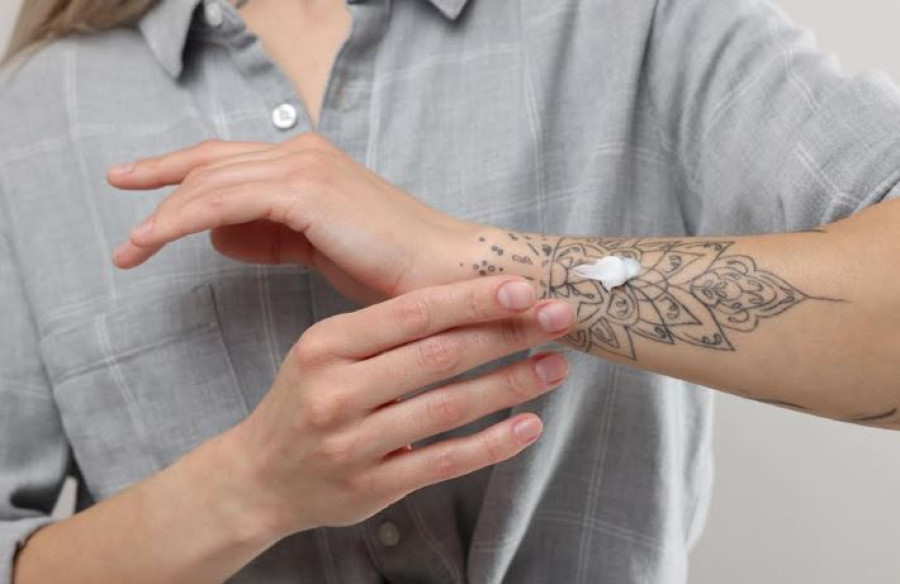Culture & Lifestyle
A guide to tattoo aftercare
Keeping your tattoo clean is vital in order to prevent infection.
Sanskriti Pokharel
Getting your first tattoo is an exciting experience. But once the ink settles, the real challenge begins: proper aftercare. How well you take care of your tattoo in the first few weeks can make all the difference in how vibrant it looks for years to come.
Dr Parash Shrestha, a consultant dermatologist at B&B Skin and Aesthetics Clinic, Gwarko, explains everything you need to know about tattoo aftercare.
What actions should one take after receiving a tattoo?
After getting a tattoo, cleanliness and proper aftercare must be prioritised. The first three days are critical, so extra caution is needed. Keep the tattooed area clean and protected to prevent infection or irritation.
Avoid strenuous physical activities that could lead to excessive movement or swelling in the area. It’s also important to keep the tattoo covered initially and ensure that water does not come into direct contact with the fresh ink, as moisture can infect the tattooed area.
What not to do when caring for a fresh tattoo?
One common mistake people make after getting a fresh tattoo is showering immediately. Water, especially from showers, pools, or baths, can introduce bacteria, potentially leading to infections. Additionally, exposure to dust, sweat, and other environmental contaminants can increase the risk of complications.
While the tattoo may appear to settle after a few days, complete healing typically takes two to three weeks, and the first four weeks are important. Proper care during this period ensures the tattoo heals well, retains its vibrancy, and prevents unwanted scarring or fading.
Are there specific skin types or conditions that require extra precautions when getting a tattoo?
Certain skin types and conditions require extra precautions when considering a tattoo. For individuals with psoriasis, getting a tattoo is not recommended because it can trigger a reaction known as the Koebner phenomenon. In this phenomenon, psoriasis lesions develop at the tattoo site, further aggravating the condition.

Similarly, those with eczema may also face complications. Another crucial factor to consider is sensitivity to tattoo ink. Some people may experience allergic reactions to certain pigments, especially the colours of tattoos, which can cause itching, swelling, or prolonged irritation. Therefore, it’s always advisable to consult a dermatologist or do a patch test before proceeding with a tattoo.
Similarly, one of the most significant concerns is keloid-prone skin. People with a history of keloid scarring should avoid tattoos, as it can lead to excessive scar tissue formation, resulting in raised, thickened scars that may become painful over time.
What should someone with sensitive skin or allergies consider before and after getting a tattoo?
If you have sensitive skin or allergies, take precautions before getting a tattoo. One of the most important steps is to conduct a sensitivity test using the specific ink applied during tattooing. This helps determine whether your skin reacts negatively to pigments, as some colours are more likely to cause allergic reactions or irritation.
Are there differences in aftercare recommendations based on tattoo placement?
The fundamental principles of tattoo aftercare remain the same regardless of where the tattoo is placed on the body. However, the healing process can vary depending on the specific area and individual differences in skin type and overall health.
Healing might take slightly longer for tattoos on areas with thicker skin, such as the back, thighs, or upper arms. On the other hand, tattoos on areas with thinner or more delicate skin, such as the wrists, ankles, fingers, or collarbones, may heal more quickly but can be more sensitive during the process.
What are the signs of skin infection due to a tattoo?
While some redness and slight swelling are normal after getting a tattoo, certain signs may indicate an infection that requires attention. If the redness persists or spreads beyond the tattooed area instead of gradually fading, it could cause concern. Excessive swelling, especially if it worsens over time rather than improving, may also signal an underlying issue.
Another warning sign is the presence of unusual discharge, such as a watery fluid, pus, or a yellowish-green substance, which may indicate an infection. Additionally, if the tattooed area becomes increasingly painful, tender to the touch, or develops a burning sensation rather than mild discomfort that subsides over time, it’s important to take it seriously.
What are some tips to maintain a tattoo’s vibrancy and prevent fading?
Keep the skin well-moisturised. Regularly applying a high-quality, fragrance-free moisturiser will help keep the tattooed area hydrated, prevent dryness, and maintain the richness of the ink.
Protecting the tattoo from direct sun exposure is crucial in the first few months after healing. Staying hydrated, following a good skincare routine, and avoiding excessive exposure to harsh chemicals or abrasive exfoliants will help preserve the tattoo’s appearance.




 8.12°C Kathmandu
8.12°C Kathmandu















